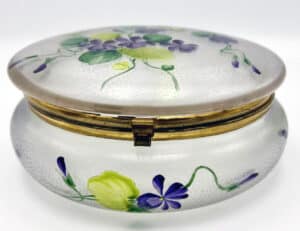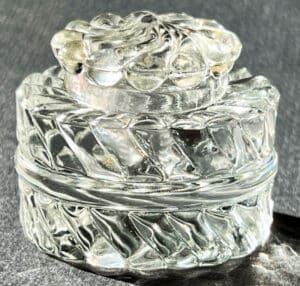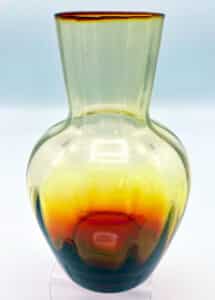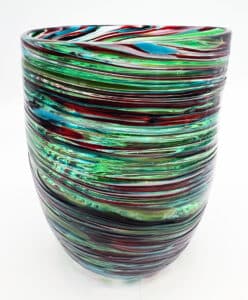By Glass Specialist Peter Wade

but obviously handmade.
It’s a beautiful, sunny day and you decide to go out for a ride and stop by an estate sale. You find a lovely piece of glass and buy it. You take your treasure home and display it and enjoy it. But, sometime soon, you may begin to wonder about this piece as you show it off to your friends and they ask you questions about your find. Was it handmade? What makes it special? Where did it come from? Who made it? Is it valuable?
You’ve just arrived in a world inhabited by many glass collectors who are passionate about the glass they own. Now, it’s your turn to embark on a quest to discover more about what you’ve found.
Your Transformation
You will quickly find that your knowledge will grow as you transition from being a casual buyer to becoming an informed buyer. In the past, glass collectors would build a home reference library to turn to for answers to these questions. Today, the home reference library now resides on the internet, and now glass collectors are becoming glass researchers.
All of that reference material you had in your personal library didn’t make it online. You will have to be imaginative in your search techniques.
It would be so nice if there was an easy way to discern what exactly you have in your hands by making just a few clicks. But that has really never been the case. While the internet provides a plethora of information, this does not necessarily mean it is correct. Many would say there is a lack of current reference material on identifying glass on the internet.
I could go on and on about these problems. I haven’t even discussed the many concerns collectors have with intentional fakes, forged signatures, etc. The important question here is, what are the solutions? Where do you go to identify your particular piece of glass?
Gather Your Evidence

Because the amount of information available to you on the internet is so vast, the first thing you have to do is to narrow down your research to a manageable level. Plus, you have to set limits on how far you will go in researching your glass. Your time is valuable, too.
Know the History of Your Glass – Understanding the history of glass objects will help you on your quest to identify a new find. Apply what you know about the piece and see where it fits into glass history and world geography. Where the glass is from can also indicate how old it is and who made it.
Make a List of Visual Indicators – Build a list of what you observe about the piece of glass in question. Questions to ask yourself are: What is it similar to? What does it look like? Does it have a pattern? Are there any marks or labels? Does the glass have seams? How would you describe its form? What are its glass characteristics? What are its design characteristics (hobnail vs. cameo glass vs. lines vs. floral vs. enamel, etc.)? What is its age? Where do you think it came from? Did the place you acquired it from give you any clues about its provenance? For market valuation, what are its condition and rarity? What if it’s
damaged? (Note: Damaged glass significantly reduces value, but, if it’s rare, it can still be quite valuable.)
Take Pictures – Today, you can Google a photo and like magic images that are similar to the ones you take pop up and you can click to see if there is any valuable information attached to the picture.
Things to Consider

Production & Labor – It is important to understand the relationship these two have when it comes to making glass. During the late 1800s, the glass marketplace was mostly made up of small artisan-style glass studios. Glass was made individually, one at a time. A lot of time and labor went into each piece, which directly equated to the purchase price. The Industrial Revolution brought this cost down, making glass more affordable to the everyday person, but was the quality of the artist’s touch still there?
Many glassmakers went out of business or were purchased by larger companies as the lower-cost competition took market share away. How many glass companies are still around today? Not many.
Currently, studio and artisan art glass is experiencing a resurgence because it still is a viable business model, albeit on a smaller scale. The level of creativity is on the upswing.
Design – The most sought-after collectible glass today is characterized by its inherent design, the quality of its craftsmanship, and the connection to its brand or manufacturer. The workers who applied their skill—the artisans who cut the glass, engraved it with beautiful embellishments, and make it appealing to the eye—built the company’s reputation for hiring quality craftsmen, making some brands more valuable.
Often these artisans are unknown. Most of them were denied the opportunity to place their mark on their workmanship. The initial designer of the piece received all the credit. Still, some engravers were fortunate enough to become known publicly and their workmanship adds substantial value to a piece.
Value – Time is money and so it is with the art of glass making. It is important to keep in mind that countless examples of Art Nouveau, Art Deco, and Art Moderne glass couldn’t be made today because they would be too costly to produce now and sell in today’s cost-conscious marketplace. Hence, you don’t see much high-end engraved glass being made today.
The Marketplace – The retail antiques and auction market is now dominated by the internet. People buy and sell glass routinely online. This is inherently
difficult when buying glass because handling it helps identify the quality and allows you to evaluate its authenticity.
Start Searching – Take your evidence together with your bulked-up knowledge and apply keywords to your search. Here is a great way to set up an inclusive first search:
Here is a good way to approach your search using these keyword terms: AKA (also known as) / Form (vase, bowl, plate, etc.) / Manufacturer (Fenton, Lalique, etc.) / Dates (estimate) / Description (shape characteristics) / Pattern (if any) / Glass Characteristics (footed, handblown, pontil mark, etc.) / Design Characteristics (Art Nouveau, Art Deco, Swedish Modern, etc.) / Most prominent Glass Descriptors (dots, stripes, color, etc.). The more you can fill in, the better.
From this initial search, you will receive a plethora of options of resources to explore online. But be aware: the results of your search will be filled with ads and ways to get you to spend your money on more glass. Take your time, skip those results marked as “Ads” (typically the top half of the page), and open information in new tabs while preserving your initial results in its own tab. Don’t think solutions will show up on the first two pages. Often, you may find something from a different website that pops up on page 4 of your search results.
Get Involved in Social Networking

Museums – Glass Societies and Organizations – Glass Clubs
Wherever you are, there is one of the above nearby. Many museums have glass collections but don’t overlook those that may have smaller specialized collections. It’s easy to find where they are online. Reach out to them and find out who is their glass curator, then contact them and ask if they can help you with your questions, or, at least, point you in the right direction.
This same approach applies to glass societies and organizations. Many of these groups have conventions where you can go to obtain hands-on access to your particular area of glass interest. In the case of glass clubs and organizations, they may have members who live in your area. Again, this may be an opportunity to expand your knowledge, gain hands-on experience and make new friendships.
Many organizations and clubs will offer to help in identifying their glass. Blenko Glass is one manufacturer that offers online access to all of their catalog publications from the 1950s to the current times. Many of these resources are available at no cost, while some charge an access or membership fee.
Many glass dealers also offer help by providing consumer-oriented information. Facebook offers many discussion groups and glass interest collecting groups. Take the time to explore them and join the groups pertinent to your interests. Most allow you to post photos to help you discern what you’ve acquired.
Retail – It used to be that antique stores were commonplace. You could easily visit them, ask questions and, often, find some wonderful treasures. Many of these stores have disappeared, especially with the arrival of the internet. Some still remain. The antique mall is an alternative, but usually, they are staffed with a sales staff with little or no specialized antique glass knowledge. Thrift stores are no better. Auction houses may offer more informed help. Some specialize in glass and it’s worth your time to investigate who they are and get to know their glass expert. Some of the larger glass auction houses have extensive databases and auction records, which you can search for relevant data and pricing information. It’s worth your time to register with them and access these files. Some really good ones are www.jeffreysevans.com/auctions/search-past-auctions/ and www.woodyauction.com/price-list/ and www.tomburnsauctions.com/.







Related posts: